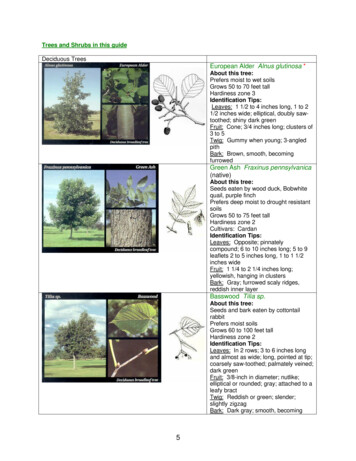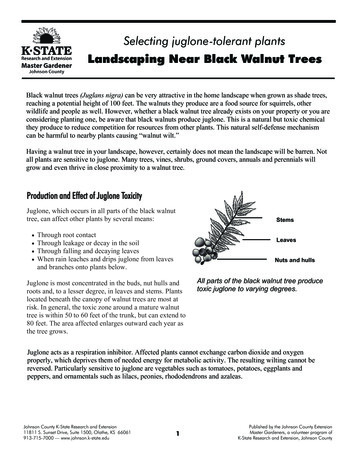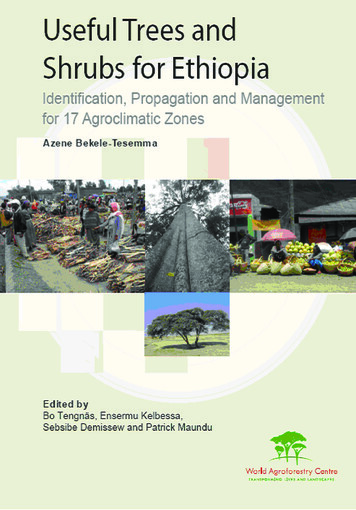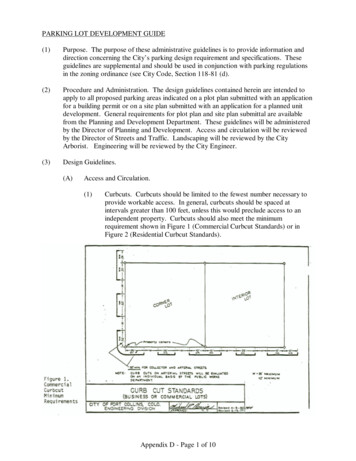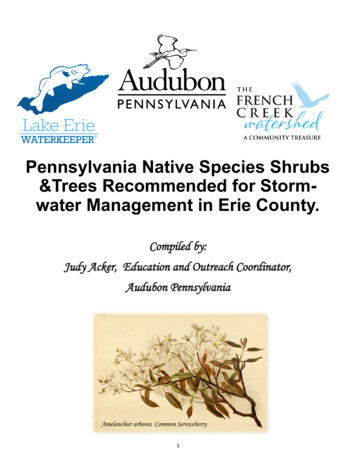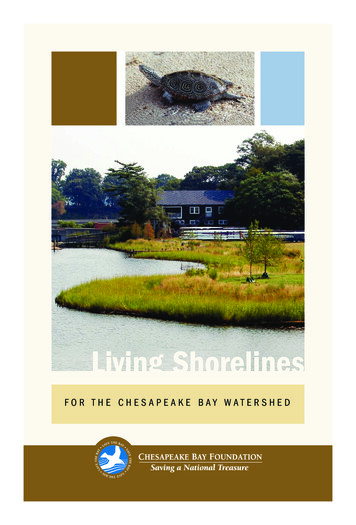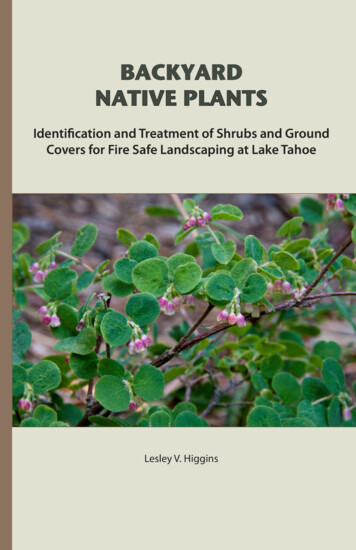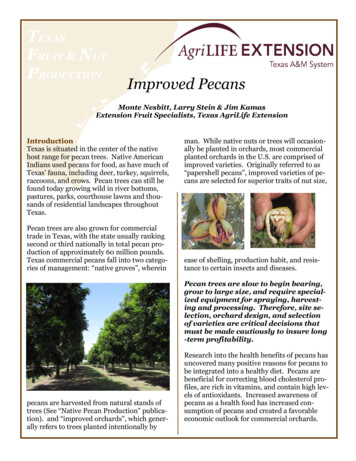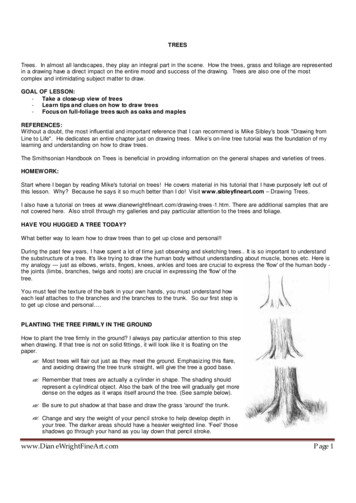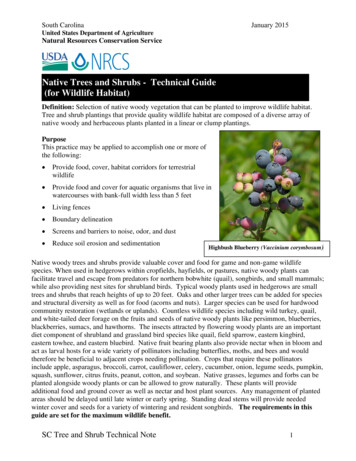
Transcription
January 2015South CarolinaUnited States Department of AgricultureNatural Resources Conservation ServiceError!NativeTrees and Shrubs - Technical Guide(for Wildlife Habitat)Definition: Selection of native woody vegetation that can be planted to improve wildlife habitat.Tree and shrub plantings that provide quality wildlife habitat are composed of a diverse array ofnative woody and herbaceous plants planted in a linear or clump plantings.PurposeThis practice may be applied to accomplish one or more ofthe following:Provide food, cover, habitat corridors for terrestrialwildlifeProvide food and cover for aquatic organisms that live inwatercourses with bank-full width less than 5 feetLiving fencesBoundary delineationScreens and barriers to noise, odor, and dustReduce soil erosion and sedimentationHighbush Blueberry (Vaccinium corymbosum)Native woody trees and shrubs provide valuable cover and food for game and non-game wildlifespecies. When used in hedgerows within cropfields, hayfields, or pastures, native woody plants canfacilitate travel and escape from predators for northern bobwhite (quail), songbirds, and small mammals;while also providing nest sites for shrubland birds. Typical woody plants used in hedgerows are smalltrees and shrubs that reach heights of up to 20 feet. Oaks and other larger trees can be added for speciesand structural diversity as well as for food (acorns and nuts). Larger species can be used for hardwoodcommunity restoration (wetlands or uplands). Countless wildlife species including wild turkey, quail,and white-tailed deer forage on the fruits and seeds of native woody plants like persimmon, blueberries,blackberries, sumacs, and hawthorns. The insects attracted by flowering woody plants are an importantdiet component of shrubland and grassland bird species like quail, field sparrow, eastern kingbird,eastern towhee, and eastern bluebird. Native fruit bearing plants also provide nectar when in bloom andact as larval hosts for a wide variety of pollinators including butterflies, moths, and bees and wouldtherefore be beneficial to adjacent crops needing pollination. Crops that require these pollinatorsinclude apple, asparagus, broccoli, carrot, cauliflower, celery, cucumber, onion, legume seeds, pumpkin,squash, sunflower, citrus fruits, peanut, cotton, and soybean. Native grasses, legumes and forbs can beplanted alongside woody plants or can be allowed to grow naturally. These plants will provideadditional food and ground cover as well as nectar and host plant sources. Any management of plantedareas should be delayed until late winter or early spring. Standing dead stems will provide neededwinter cover and seeds for a variety of wintering and resident songbirds. The requirements in thisguide are set for the maximum wildlife benefit.SC Tree and Shrub Technical Note1
January 2015South CarolinaGeneral Criteria and SpecificationsPlantingA minimum of 3 native woody plant species should be planted. To promote higher diversity,additional species of woody trees and shrubs, native grasses, forbs, and legumes can be planted.This greatly enhances habitat for songbirds, northern bobwhite (quail), wild turkey, and pollinators.The species selected shall be chosen from the approved lists in Tables 1 and 2.Use the 2 Habitat Categories to guide species selection based on the site conditions1. Upland fields and/or buffers and/or within or around cropfields, hayfields, or pastures (Table 1).2. Riparian buffers, wetland edges, streambanks (Table 2).REQUIREMENTSMinimum width for wildlife benefit is 30 feet.Generally, wider corridors accommodate morewildlife use and better songbird nest success.Native species must be used. Chose speciessuited and adapted to the soils, climate andconservation purpose on the site.Soil preparation: Soil should be prepared byconventional disking methods; or by herbicidetreatments when a prevalence of exotic sodforming grass competition like fescue, bahia,or bermuda grass exists on site. After planting,pack soil firmly around roots and protect plants from damage by traffic, fire, livestock, and weedcompetition. Fertilizer may be used to increase productivity of fruit-bearing species.If planning in linear fashion, plantings should be made in multiple rows with spacing toaccommodate growth for species used.Plant woody bare-root or potted shrubs and trees during the dormant season (November throughMarch). Spacing: Trees - 12 feet apart, Shrubs - 6feet apart; or to simplify, all plants 10 to 12 feetapart.Tree and shrub shelters must be used where deer andsmall mammal browse is problematic.If linear as with a hedgerow, the center row shouldconsist of the tallest growing species and the averageheight of the vegetation should decrease toward theouter edges of the hedgerow. If native grasses and/orforbs are planting or allowed to grow naturally, theyshould be at the outer edges of the rows, between thecropfield and the woody shrubs and trees.SC Tree and Shrub Technical NoteYaupon Holly (Ilex vomitoria)2
January 2015South CarolinaIf native grasses and/or forbs are to be planted, please refer to the SC NRCS Tech Guide 327 (a) forspecies selection, site preparation, planting and maintenance information.No plant listed in Table 3; or by the State as a Noxious Weed; or listed by the SC Exotic PestPlant Council shall be established in a tree and shrub planting. See these websites for officialexotic plants lists: http://plants.usda.gov/java/noxious?rptType State&statefips s.pdfOn pastureland, protect plants from livestockgrazing and trampling.ConsiderationsMake sure all site prep or plantingequipment is cleaned prior to use on site toprevent seeds, rhizomes or other materialfrom invasive exotic plants from beingbrought to the site.Linking fragmented habitats may increasewildlife use of an area.Habitat quality and food supply can be improved byallowing wild blackberries to grow within hedgerowIn plantings adjacent to small watercourses, the plantings shall be site-adapted, large enough atmaturity and installed close enough to shade the watercourse.In grassland ecosystems, trees and shrubs may adversely affect area-sensitive nesting birds byfragmenting grassland habitat patches and increasing the risk of predation. Consult an NRCSBiologist when planning on larger grassland tracts.MaintenanceCompeting vegetation shall be controlleduntil the trees and shrubs becomeestablished by mowing in between rows orspot herbicide treatment until plantings isfully established. Control shall continuebeyond the establishment period, ifnecessary.Noxious weeds will be controlled bymowing, fire, tillage, or herbicides asappropriate. If using fire, slow burningwinter fires are best for hardwoods.Herbicides are recommended as the bestalterative because of long lasting effects.Spot treat as necessary.Hawthorn (Crataegus sp.)SC Tree and Shrub Technical Note3
January 2015South CarolinaCommon NameMockernut HickoryPignut HickoryPersimmonBlack WalnutEastern Red Cedar(evergreen)BlackGumShortleaf Pine(evergreen)Longleaf Pine(evergreen)White OakScarlett OakSouthern Red OakNorthern Red OakPost OakBlack OakLive OakRedbudFlowering DogwoodAmerican HollyWild Black CherryShadblow ServiceberryCoastal PlainServiceberryPaw PawSilky DogwoodSwamp/Stiff DogwoodDeciduous Holly,PossumhawWinterberrySouthern CrabappleRed MulberrySassafrasChinquapinMayhawCockspur HawthornOne flower HawthornDahoon Holly(evergreen)TABLE 1: Native Woody Plants for Upland Habitats, Hedgerows and Field EdgesFormwhere to plantScientific Namedry woodsCarya tomentosatreedry to moist woodsCayra glabratreeuplands, old fieldsDiospyros virginianatreemoist woodsJuglans nigratreeuplandsJuniperus virginianatreeuplands and low woodsNyssa sylvaticatreeold fields and uplandsPinus echinatatreesandy soilPinus palustristreeRegion best estatewidestatewidecoastal plain, piedmontQuercus albaQuercus coccineaQuercus falcataQuercus rubraQuercus stellataQuercus velutinaQuercus virginianaCercis canadensisCornus floridaIlex opacaPrunus serotinaAmelanchier canadensisAmelanchier obovalistreetreetreetreetreetreetreemedium treemedium treemedium treemedium treesmall treesmall treeuplands, slopespoor soil, dry uplandsdry woodsmoist soil, slopesdry, poor, or rich soildry, well drained soilsandy, dry soilsuplands, dry to moistmoist uplands, slopeswell drained, moist soilanywhere, dry to moist soilsandy uplandsmoist soilAsimina trilobaCornus amomumCornus stricta, CornusfoeminaIlex decidua (keepsberries in winter)Ilex verticillataMalus angustifoliaMorus rubraSassafras albidumsmall treesmall treemoist soil, slopesmoist soilsmall treesmall treemoist soilmoist soilsmall treesmall treesmall treesmall treemoist soilwell-drained, moist soilmoist soilmoist, well-drained sandy loamsstatewideCastanea pumilaCrataegus aestivalisCrataegus crus-galliCrataegus unifloraIlex cassinelarge shrublarge shrublarge shrublarge shrublarge shrubdry woods, old fieldsmoistdry to moistdryanywherestatewidestatewidepiedmont, mtnscoastal plain, piedmontpiedmont, mtnsstatewidestatewidecoastal plain, l plain, piedmontcoastal plain, piedmontSC Tree and Shrub Technical Notepiedmont, mtnsstatewidestatewidecoastal plain, piedmontstatewidestatewidestatewidecoastal plainstatewidestatewidecoastal plain4
January 2015South CarolinaCommon NameLead Plant/FalseIndigobushBeautyberryNew Jersey TeaStrawberry BushTABLE 1 (cont.): Native Woody Plants for Upland Habitats, Hedgerows and Field EdgesFormwhere to plantScientific NamedryuplandAmorpha herbaceashrubRegion best suitedstatewideCallicarpa americanaCeanothus americanusEuonymus americanashrubshrubshrubdry to wetwell drained, open, sandy soilsmoist, shadyYaupon HollyIlex vomitoriashrubwell drained to wetWax Myrtle/SouthernBayberryNinebarkAmerican PlumMorella cerifera orMyrica ceriferaPhysocarpus opulifoilusPrunus americanashrubwet to dryshrubshrubbogs, stream banks, moist bluffsmoist to dryChickasaw PlumPrunus angustifoliashrubmoist to drystatewidestatewidestatewidecoastal plain, piedmontcoastal plain, piedmontstatewidecoastal plain, piedmontstatewideCarolina Laurel Cherry(evergreen)Hog Plum, FlatwoodsPlumCarolina RoseSparkleberryPrunus carolinianashrubwell-drained moist soilPrunus umbellatashrubmoist to dryRosa carolinaVaccinium arboreumshrubshrubmoist to drydry to moiststatewideHighbush BlueberryBlack-berried HighbushBlueberrySquaw Huckleberry,DeerberrySmall Black BlueberryArrowwoodVaccinium corymbosumVaccinium fuscatum(atrococcum)Vaccinium stamineumshrubshrubmoist soildry to wetstatewideshrubmoist to dryVaccinium tenellumViburnum dentatumshrubshrubdry uplanddry to wetBlue Haw, Rusty BlackHawViburnum rufidulumshrubdry soilsCoral HoneysuckleLonicera sempervirensvinemoist to drystatewideVirginia CreeperParthenocissusquinquefoliavinemoist uplands, shade tolerantstatewidecoastal plain, l plain, piedmontstatewidestatewideSC Tree and Shrub Technical Note5
January 2015South CarolinaCommon NameBox ElderRed MapleSweet or Black BirchRiver BirchIronwood, Am.HornbeamShagbark HickoryHackberry/SugarberryTABLE 2: Native Woody Plants for Riparian Areas and WetlandsFormarea to plantScientific Namesemi- wet/ edges, swamp forests,streamsAcer negundotreesemi- wet/ edges, swamp forests,Acer rubrumtreestreamsstreambanks, rich woods, northBetula lentatreefacing slopessemi- wet/ edges, river and streambanksBetula nigratreeCarpinus carolinianaCarya ovataCeltis laevigatatreetreetreestreambanks, low or rich woodslow woodsalluvial woodsAtlantic White CedarPersimmonChamaecyparis thyoidesDiospyros virginianatreetreeGreen AshBlack WalnutSweetgumFraxinus pennsylvanicaJuglans nigraLiquidambar styracifluatreetreetreeTulip PoplarSycamoreLirodendron tulipiferaPlatanus occidentalistreetreeacid swamps, bogs, wet sandssurrounding uplandssemi- wet/ edges, swamp forests,streamsrich woods, stream marginslow, rich woodssemi- wet/ edges, swamp forests,streamslow woodsEastern CottonwoodSwamp CottonwoodSwamp Laurel OakPopulus deltoidesPopulus heterophyllaQuercus laurifoliatreetreetreeOvercup OakQuercus lyratatreeSwamp Chestnut OakWater OakQuercus michauxiiQuercus nigratreetreeCherrybark OakQuercus pagodatreeWillow OakQuercus phellostreeShumard OakQuercus shumardiitreeShawblow ServiceberryDevil's Walking StickAlamanchier arboreaAralia spinosasmall treesmall treePaw PawAsimina triolobasmall treeSilky/Swamp Dogwoodsmall treeSwamp/Stiff DogwoodDeciduous HollyCornus amomumCornus stricta, CornusfoeminaIlex deciduaWinterberryRed MulberryIlex verticillataMorus rubrasmall treesmall treeRed ChokeberryPhotinia pyrifolia(Aronia arbutifolia)SC Tree and Shrub Technical Notesmall treesmall treesmall treeRegion best suitedstatewidestatewideMtns (Greenville,Pickens)statewidestatewidepiemont, mtnsstatewidestreambanks, swamp forestsswamp forests, streambanksmoist soilsswamp forests, poorly drainedlowlandsmoist, well-drained alluvialfloodplainswet lowlands to moist uplandsbottomland hardwood, well-drainedlowlandsmoist alluvial soils along streamsand riverswell drained soils along streamsand riversbluffs, stream banksupland and low woodsstream banks, low woods,floodplainssemi- wet/ edges, swamp forests,streamsstream banks, alluvial woods,swamp forestsupland and alluvial forestsfloodplains, bogs, along streams,low woodsalluvial woods and adjacent lowerslopemoist woods, swamps, bogs, bluffs6Coastal Plain, idestatewidePiedmont, inner coastalplainCoastal PlainPiedmont, Coastal PlainPiedmont, Coastal PlainPiedmont, Coastal PlainstatewidestatewidestatewidePiedmont, Coastal Plainstatewidestatewidemtns, piedmont, inner CPstatewidestatewidePiedmont, Coastal Plainstatewidestatewidestatewide
January 2015South CarolinaCommon NameTABLE 2 (cont.): Native Woody Plants for Riparian Areas and WetlandsFormarea to plantScientific NameAlternate LeavedDogwoodCornus alternifolialarge shrubHawthornCrataegus viridis, C.spathulata, C. marshalliilarge shrubWitch HazelHamamelis virginianalarge shruballuvial woods, swamp forestsrich or dry woods, surroundingslopesMockorangePhiladelphus inodoruslarge shrubrich woods, floodplainsCommon NinebarkPhysocarpus opulifoliuslarge shrubbogs, streambanks, moist cliffs,Piedmont, MountainsCoastal Plain WillowSalix carolinianalarge shrubstreambanks, low, moist areasCoastal Plain, PiedmontBlack WillowSalix nigralarge shrubstreambanks, low, moist areasstatewideSilky WillowSalix sericealarge shrubstatewideTag AlderFalse Indigo/RiverLocustAlnus serrulataAmorpha fruticosashrubshrubmarshes, ditches, low woodsstreambanks, swamp edge, wetmeadowAsimina parviflorashrubdry to moistdrier edges, surrounding uplandsstatewideDwarf Paw PawGroundselshrubopen wet edgesButtonbushBaccharis halimifoliaCephalanthusoccidentalisshrubwet shorelines, swampsSweet PepperbushClethera alnifoliashrubsemi- wet/ edges, pocosins, baysHazel-nutCorylus americanashrubrich woodsTitiCyrilla racemeflorashrubsemi- wet/ edges, bays, poccosinsVirginia WillowItea virginicashrubCoastal DoghobbleLeucothoe axillarisshrubsemi-wet/ wet, low woodsalong streams, bays, pocosins,swamp forestHighland DoghobbleLeucothoe fontainissimashrubDog Hobble/FetterbushLeucothoe racemosashrubSpicebushLindera benzoinshrubFetterbushLyonia lucidashrubWax MyrtleMorella/Myrica ceriferashrubCommon ElderberrySambucus canadensisHighbush BlueberryArrowwood ViburnumRegion best suitedmoist woodlands, stream andswamp bordersPiedmont, MountainsPiedmont, Coastal PlainstatewidePiedmont, MountainsstatewidestatewidePiedmont, MountainsstatewideCoastal Plain, Piedmontstatewidealong streamsswamps, bogs, streambanks,savannahsPiedmont, Coastal PlainstatewideCoastal Plain, PiedmontmountainsCoastal Plain, Piedmontstream margins, alluvial woodssemi- wet/ edges, pocosins, lowwoodsstatewideCoastal Plain, PiedmontPiedmont, Coastal Plainshrublow woods, marshesrich soils along riverbanks andforest edgesVaccinium corymbosumshrubmoist bays, swamps, steamsidesPiedmont, Coastal PlainViburnum dentatumshruballuvial woods, swamp forestsSC Tree and Shrub Technical Notestatewidestatewide7
January 2015South CarolinaTable 3: Invasive exotic plants or noxious weeds that should NOT be planted or encouraged:Common NameScientific NameformCommon NameScientific NameFormAutumn OliveEleaegnus umbellataShrubWhite MulberryMorus albaTreeRussian OliveEleaegnus angustifoliaShrubCamphortreeCinnamomum camphora TreeThorny Olive/SilverthornEleaegnus pungensShrubWhite PoplarPopulus albaTreeBush/Amur HoneysuckleLonicera maackiiShrubSweet Breath of SpringLonicera fragrantissimaShrubJapanese Climbing FernWintercreeperLygodium japonicumEuonymous fortuneiVineVineChinese PrivitLigustrum sinenseShrubCommon PeriwinkleVinca minorVineJapanese/Glossy PrivitLigustrum japonicaShrubBigleaf PeriwinkleVinca majorVineMultiflora RoseRosa multifloraShrubJapanese HoneysuckleLonicera japonicaVineCherokee RoseRosa laevigataShrubEnglish IvyHedera helixVineMacartney RoseRosa bacteataShrubKudzuPueraria montanaVineWinged Burning BushEuonymus alataShrubChinese or JapaneseWisteriaWisteria sinensis,Wisteria floribundaVineSacred Bamboo, NandinaNandina domesticaShrubBeach VitexVitex rotundifoliaVineTropical Soda AppleSolanum viarumShrubCogongrassCrabgrassImperata cylindricaDigitaria sanguinalisGrassGrassLeatherleaf MahoniaMahonia bealiiShrubCascade Oregon GrapeMahonia nervosaShrubJohnson GrassSorghum halapenseGrassScotch BroomCytisus scopariusShrubBermuda GrassCynodon dactylonGrassTall FescuePoncirus trifoliataTriadica sebiferaShrubTreeLolium arundinaceum/Festuca arundinaceaGrassTrifoliate OrangeChinese Tallow TreeBahiagrassPaspalum nototumGrassChinaberryMelia azedarachTreeMimosaSawtooth OakAlbizia julibrissinQuercus acutissimaTreeTreeGiant ReedNepalese BrowntopArundo donaxMicrostegium vimineumGrassGrassChinese SilvergrassMiscanthus sinensisGrassTree of HeavenAilanthus altissimaTreeGolden BambooChinese Lespedeza orSericeaShrubby or BicolorLespedezaPhyllostachys aureaLespedeza cuneataGrassForbLespedeza bicolorForbCallery Pear/Bradford Pear Pyrus calleryanaPrincess Tree/RoyalPaulowniaPaulownia tomentosaSC Tree and Shrub Technical NoteTreeTree8
January 2015South CarolinaSite Specific Comments and Recommendations: USDA-NRCSTree and Shrub Planting – GuidanceLandowner Field numberPurpose (check all that apply) Provide wildlife food, cover, and habitat corridors in farm land Reduce soil erosion and sedimentation Provide food and cover for aquatic organisms in riparian habitat Create screens and barriers to noise, odor, and dustLayoutPlanting 1Planting 2Planting 3Planting4Planting width (feet)Planting length (feet)Area (acres)Species # 1# plants-Species # 2# plants-Species # 3# plants-Species # 4# plants-Species # 5# plants-Species # 6# plants-Species # 7# plants-P2O5 (lbs/acre)K2O (lbs/acreTemporary Storage InstructionsPlanting stock that is dormant may be stored temporarily in a cooler or protected area. For stock that is expected to begingrowth before planting, dig a V-shaped trench (heeling-in bed) sufficiently deep and bury seedlings so that all roots arecovered by soil. Pack the soil firmly and water thoroughly.Site PreparationRemove debris and control competing vegetation to allow enough spots or sites for planting and planting equipment. Forcontainer and bareroot stock, plant stock to a depth even with the root collar in holes deep and wide enough to fullyextend the roots. Pack the soil firmly around each plant. Cuttings are inserted in moist soil with at least 2 to 3 budsshowing above ground. Additional requirements:Planting MethodTrees and shrubs must be inspected periodically and protected from damage so proper function is maintained. Replacedead or dying tree and shrub stock and continue control of competing vegetation to allow proper establishment. Periodicharvesting of trees and shrubs may be necessary to maintain the health and vigor of mature stands. Additionalrequirements: Trees should be planted at 12 ft. by 12 ft. spacing, shrubs at 6 ft. by 6ft. spacing (or all plants at 10 ft. by10 ft. or 12 ft. by 12 ft. spacing). Use tree and shrub shelters to protect against deer and small mammal browse.SC Tree and Shrub Technical Note9
South CarolinaJanuary 2015Operation and MaintenanceMaintain original purpose of planting. Competing vegetation shall be controlled until the trees and shrubs becomesestablished by mowing in between rows or spot herbicide treatment until established. Shut off pesticide sprayers whenturning near trees and shrubs. Noxious weeds in established plantings will be controlled by mowing, fire, tillage, orherbicides as appropriate. Additional requirements:Additional Specifications and Notes:The United States Department of Agriculture (USDA) prohibits discrimination in its programs on thebasis of race, color, national origin, sex, religion, age, disability, political beliefs and marital orfamilial status. (Not all prohibited bases apply to all programs.) Persons with disabilities who requirealternative means for communication program information (Braille, large print, audiotape, etc.)should contact the USDA Office of Communications (202) 720-2791.To file a complaint of discrimination write USDA, Director, Office of Civil Rights, Room 326-W,Whitten Building, 14th and Independence Avenue, SW, Washington, DC 20250-9410 or call (202)720-5964 (voice or TDD). USDA is an equal opportunity provider and employer.SC Tree and Shrub Technical Note10
South Carolina January 2015. SC Tree and Shrub Technical Note . 3 If native grasses and/or forbs are to be planted, please refer to the . SC NRCS Tech Guide 327 (a) for species selection, site preparation, planting and maintenance information. No plant listed in Table 3; or by the State as a Noxious Weed; or listed by the SC Exotic Pest
